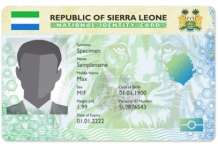By Amin Kef Sesay
In this country the marketing of petroleum products is mainly done by privately owned companies though there is a State regulatory institution which, from time to time, ensures that sanity prevails within the petroleum landscape. Government sometimes steps in to give subsidies in order to absorb the shocks that emanate from the changes in market forces which have tendencies of affecting the pump price so that the cascading effects will not be overbearing for the ordinary man on the street.
Research has shown that the country consumes in excess of 1.1 million litres of petroleum products per day but the country can only store 40% of what is used per day. This means that there is frequent replenishment which is done every two weeks. This kind of situation has made certain unscrupulous individuals seize the opportunity to hoard petroleum products or speculate against the availability of petroleum products.
It must be noted that Sierra Leone does not determine oil prices. The prices of petroleum products are determined by a combination of the international Oil reference price (PLATTS) and the foreign exchange rate.
In other words, the pump price of petroleum products, including petrol, diesel, kerosene etc. in the country, is efficiently determined by a +/-5% trigger mechanism of the landed cost, that is the cost of landing the shipped petroleum products in the country and that is mostly driven by the combined effect of the International Oil Reference Price (Platts) and available as well as accessible Foreign Exchange.
However, the country’s pricing regime is well structured, transparent and reviewed monthly. From what this medium gathered, pump prices of petroleum products changed six (6) times since 2018 and out of those, it was reduced three (3) times during that period.
It is good to note that in spite of the hike in global prices, the Government of Sierra Leone has kept the pump price of petrol and diesel unchanged at Le8, 500 per litre which comparatively is far lower than per litre prices in the entire West African sub-region. In other words, the country’s fuel prices are the lowest in the sub-region. See the comparison:
Run-down of the prices of petroleum products on a comparative basis of former regional fuel price converted in Le/Litre as at 31st May, 2021 taking into consideration Sierra Leone, Guinea, Liberia, Ivory Coast, Ghana and The Gambia are as follows: Petrol– Sierra Leone Le 8,500.00, Guinea: Le 9,450.00, Liberia: Le 7,879.33, Ivory Coast: Le 11,728.05, Ghana: Le 11,240.11, The Gambia Le 11,453.17.
For Diesel the comparison is as follows: Sierra Leone: Le 8,500.00, Guinea: Le 9,450.00, Liberia: Le 9, 192.49, Ivory Coast Le 11, 728.05, Ghana: Le 11, 172.45, The Gambia: Le10, 904.09.
In terms of Kerosene the comparison is as such: Sierra Leone: Le 8, 500.00, Guinea -, Liberia: Le13, 279.25, Ivory Coast Le10, 583.85, Ghana: Le9, 076.84, The Gambia: Le 8,573.04.
The Exchange Rate source is the Bank of Sierra Leone as at June, 3rd 2021.
This medium was further made to understand that between May and December 2020, although there were oil price increases all over the sub-region and in the world, the Government did not allow the high costs to be passed on to the poor consumers. At first Government suspended the automatic pricing adjustment mechanism since May 2020 to date.
Government intervened by injecting about Le66bn during that period and Le17.43bn in January 2021 to support the pump price stabilization. Again, since May 2020 to June 2021 Government has subsidised about Le132.11bn.
One thing that kept coming up throughout our investigation was that a significant portion of benefits from fuel subsidies are not received by the intended beneficiaries in Sierra Leone. Rather, these petroleum products are captured by smugglers and black marketers.
It was discovered that it is more profitable for smugglers to buy subsidized fuel domestically on the black market, and then smuggle it and sell at market rates in neighbouring countries thereby depleting our stocks faster leading to shortages and panic buying.
Against the backdrop of the rise in the price of crude oil on the world market as it is at this material time, the rate and manner in which the Government of Sierra Leone will continue to sustain leveraging subsidy on petroleum products could largely depend on how much Government will continue to mobilize additional revenue over a specific period of time. This is worthy of note when cognizance is taken of the fact that there are other areas that need urgent Government financing to foster overall national development.
However, what is for now certain is that conditions on the world market are not favorable in terms of seeing a downward trend in the prices of petroleum products and it is something that is bound to affect developing nations the most with Sierra Leone not being an exception.






